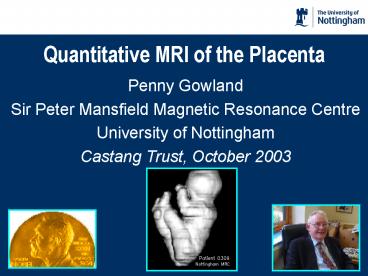Quantitative MRI of the Placenta - PowerPoint PPT Presentation
1 / 28
Title:
Quantitative MRI of the Placenta
Description:
macromolecule concentration (MT, T2) water binding (T1, T2) Tissue oxygenation? ( T2) ... to lie over basal plate (only identified in certain orientations) ... – PowerPoint PPT presentation
Number of Views:248
Avg rating:3.0/5.0
Title: Quantitative MRI of the Placenta
1
Quantitative MRI of the Placenta
- Penny Gowland
- Sir Peter Mansfield Magnetic Resonance Centre
- University of Nottingham
- Castang Trust, October 2003
2
MR in pregnancy?
- Uterine abnormalities
- Pelvimetry
- Structural scanning for congenital abnormalities.
39 weeks
3
qMRI in pregnancy?
- Assessing fetal growth
- Quantifying utero-placental blood flow and
placental structure. - Monitoring fetal organ maturation, in particular
fetal brain development.
4
Anatomical MRI
5
Organ volume measurement
- Can organ volume measurements predict FGR with
high specificity?
36 weeks
6
Comparison to ultrasound
- Standard 2D Ultrasound uses growth charts to
relate 1D measurements (eg crown-rump length) to
fetal weight - 3D ultrasound is being introduced
- Ultrasound results are adversely affected by
bowel gas, amniotic fluid and obesity
Placenta
Fetal Brain
Fetal Liver
Fetal Lung
36 weeks
7
Liver volume measurements in FGR
FGR Normals
US
MRI
8
Liver volume measurements in FGR
Underestimation by 3D ultrasound
Normals
FGR
3-D Ultrasound
Ribs probably lead to underestimation with
ultrasound. Ultrasound data taken from Laudy et
al. Ultrasound Obstet Gynecol 1998
9
Fetal brain volume MRI v US
USS
MRI
18 GA (weeks) 40
10
Functional MRI
- Placental structure
11
Placental transverse relaxation
Single spin-echo EPI
Magn. Res. Imag., 16, 3, 241-246, 1998.
12
Placental longitudinal relaxation
NS/S IR EPI
Magn. Res. Imag., 16, 3, 241-246, 1998.
13
Placental structure
- Infection would classically increase relaxation
times - Thrombosis would decrease relaxation times
- Lesions usually bright
- NMR relaxation times give information about
tissue properties - macromolecule concentration (MT, T2)
- water binding (T1, T2)
- Tissue oxygenation? (T2)
- viscoelastic properties in future?
14
Functional MRI
- Blood flow through the placenta
15
Blood flow through placenta
- Determined by
- maternal delivery to placenta
- fetal placental flow
- mixing within the placenta
- MRI can measure
- uterine artery blood flow
- spiral artery blood movement
- movement of blood in placenta
16
Uterine vessel blood flow
Fetal brain
Uterine vein
Static
Flowing
17
Placental blood movement
- Inflow (FAIR)
- similar to perfusion, multidirectional
- Gradient sensitization (IVIM)
- a moving blood volume which depends on blood
velocity and sequence parameters - Tagging ?
- Transit times ?
18
FAIR Perfusion
gt1000 500-1000 300-500 lt100
Perfusion rate ml/100g/min
19
Perfusion Histograms
Low perfused fraction increased for low IBR
Lancet 19983511397-99
20
Measuring IVIM perfusing fraction
- f measures the volume of randomly flowing blood
as a fraction of the voxel-volume of water
21
Raw IVIM images
- Regions of interest data fitted to 4 parameters
- S(b) So f e-bD (1-f) e -bD
- D diffusion coefficient, D is the
pseudodiffusion coefficient, f is the perfusing
fraction
0545
b 3 s/mm
b 15 s/mm
2
2
Fluid
Lungs
b 80 s/mm
b 47 s/mm
2
2
22
Placental IVIM summary
- Normal placenta generally maternal zone contains
a significantly greater perfusing fraction
compared to the fetal zone. - Compromised pregnancy generally the maternal
zone has a reduced perfusing fraction however,
the fetal zone appears normal
IUGR
Normal
Perfusing fraction ()
0
50
100
23
IVIM of basal plate
- 3 pixel width ROI chosen to lie over basal plate
(only identified in certain orientations) - Measure the pattern of signal attenuation in this
region - Eliminate scans affected by motion
Basal plate ROI
24
Basal plate IVIM
60
Normal Longitudinal
50
Normal Cross sectional
Pre-eclampsic
40
IUGR
f
30
Cross sectional groups f reduced in PE (p lt
0.005)
?
20
10
0
15
25
35
45
Gestation (weeks)
- Depends on
- Blood volume AND blood velocity
- Number of spiral arteries recruited
- Lumen diameter
25
Fetal maturation
20 weeks 053301
26 weeks 056902
Brain
Liver
Lung
20 weeks
26 weeks
26
Fetal fMRI
Results
Hearing
Seeing
27
Conclusion
- MRI has the potential to become an important tool
in - managing fetuses with abnormalities
- managing compromised pregnancies
- understanding the aetiology of IUGR and PE
- studying normal and abnormal fetal brain
development - Prospective studies, and more detailed studies of
high risk pregnancies are required.
28
Acknowledgements
- Physicists
- Jon Fulford
- Rachel Moore
- Damien Tyler
- Sir Peter Mansfield
- Biologists
- Billy Dunn
- Terry Mayhew
- Technical
- Paul Clark
- Ron Coxon
- Clinicians
- Ian Johnson
- Phil Baker
- Stephen Ong
- Keith Duncan
- David James
- Bryony Strachen
- Shantilla Vadeyar
- Our Volunteers































